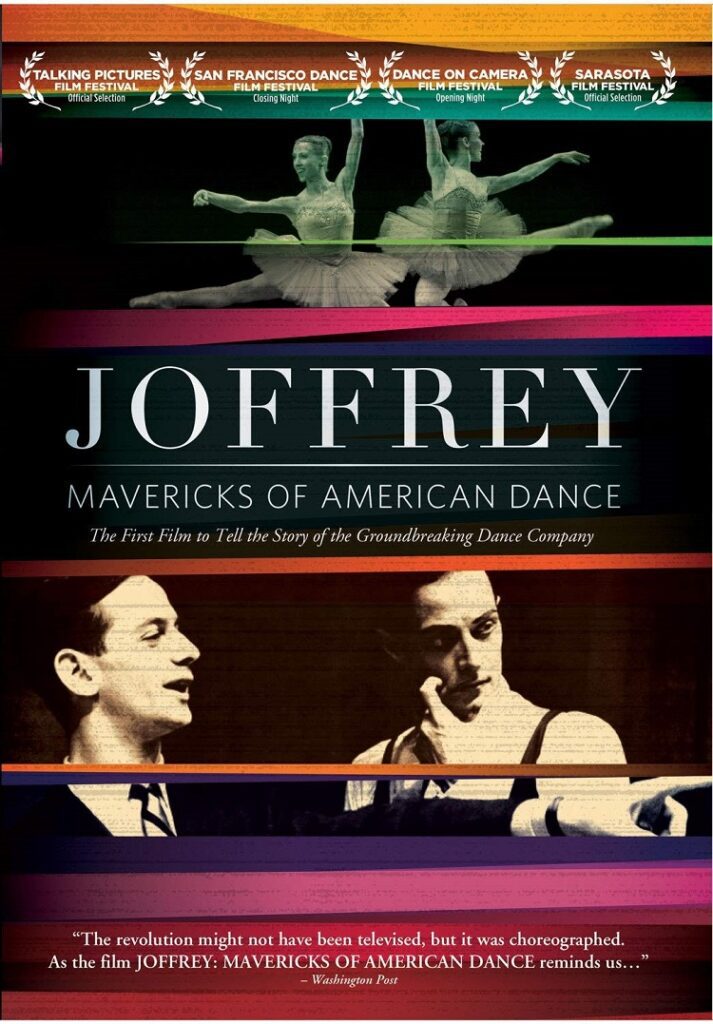
Joffrey: Mavericks of American Dance does what ballet so often fails to do: it draws laymen into a world perceived to be reserved solely for upper-crust patrons with a penchant for tutus and tiaras. That the Joffrey Ballet is the company to compel is fitting. In true startup fashion, it began as the underdog of American dance and remains the underdog of American dance, with no shortage of pioneering, persevering, and upsetting the status quo in between. It’s a company that champions diversity while taking great pride in homegrown talent. And since the middle of the last century, it has used its repertoire and dancers to comment on society, rather than simply tell fairy tales of old.
Written and directed by Bob Hercules and narrated by Mandy Patinkin, Joffrey takes viewers on a visual road trip beginning in Seattle circa 1948, when kindred spirits Gerald Arpino and Robert Joffrey set off to New York City to realize their dream of starting a “truly American ballet company.” From there we see the formation of their six-dancer-strong Robert Joffrey Theater Dancers in 1956 and the company’s subsequent tour of 23 one-night stands throughout the country, not by plane or bus—by station wagon.
It is capturing the sense of freedom, fortitude, exhaustion, and exhilaration felt by the company members and its founders from that first tour in 1956 to their tour of the Middle East in 1962 to severing ties with the Rebekah Harkness Foundation in 1964 (which sent the company into round one of Operation: Reinvention) that this documentary excels. Candid, intimate photographs exhibiting the camaraderie of the troupe in its infancy are many, and frank narration by the dancers, business partners, and Joffrey and Arpino tell a story of real people with big ideas figuring out how to fuse their personal dance histories in a way that could sell the public on ballet in its most innovative form.
Throughout the 1960s and early 1970s, we see the Joffrey engage with and put their personal spin on the American counterculture. The documentary spends a good deal of time on the revival of Kurt Jooss’ “anti-war ballad” The Green Table and Robert Joffrey’s groundbreaking “psychedelic rock ballad” Astarte, which landed Joffrey dancer Trinette Singleton on the cover of Time magazine in March 1968. Always flowing with the times, the 1980s and 1990s are depicted as an era of struggle and evolution for the company, when fearlessness and progressiveness gave way to harsh financial times and the reality of the AIDS epidemic, the latter of which claimed Robert Joffrey in 1988.
To the present day, the Joffrey story remains one of loyalty—to its dance family, to the audience, and to the art form. Although the financial fate of the company has rested in several hands, its artistic direction has been bequeathed to a new generation following Gerald Arpino’s resignation in 1990, and its roots have been replanted in Chicago, former Joffrey dancers who now head some of America’s most prolific companies (Kevin McKenzie, artistic director of American Ballet Theatre [ABT], and Helgi Tomasson, artistic director of San Francisco Ballet) are proof that the company has a knack for turning out future stars with big dreams, very much in the spirit of its founders.
There is very little to dislike about this film; however contextualizing the Joffrey’s place on the world stage could have made its story even more powerful. It is dubbed the “current events company” in a space dominated by ABT, the classical company, and New York City Ballet, the Balanchine company—but it would have been interesting to glimpse what these and other companies were doing simultaneously and how the Joffrey streamlined its repertoire to compete. Or perhaps Hercules and the producing team (including Harold Ramis) chose to omit the competition from the story to further emphasize the Joffrey’s singularity in the dance world. Either way, its history is a fascinating and touching one, and it speaks volumes about the performing arts’ struggle to survive throughout the past several decades.
Joffrey: Mavericks of American Dance premieres in New York with a one-week engagement beginning Friday, April 27, at New York’s Cinema Village Theaters. The premiere weekend includes Q&As with the filmmakers and a panel of past Joffrey dancers and dance journalists.